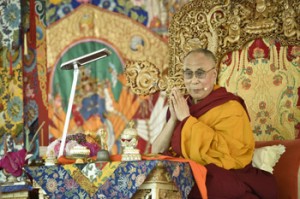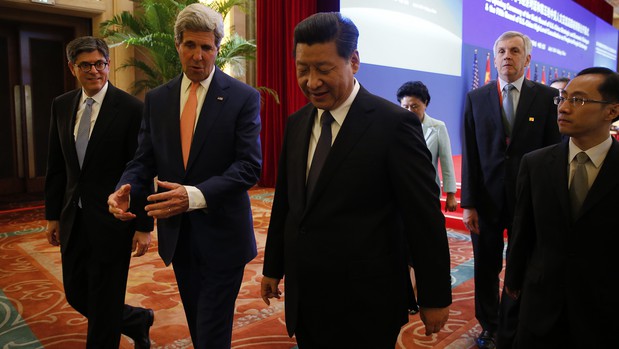Preparatory Procedures for the Kalachakra Empowerment
[dalailama.com] Leh, Ladakh, J&K, India, 10 July 2014 – His Holiness the Dalai Lama went to the teaching pavilion early in the morning today and spent four hours performing the self-generation rituals. When he returned from lunch, in the heat of the day, an estimated 144,000 people had gathered to take part in the preparatory procedures for the Kalachakra Empowerment. He came out to the front of the platform of the pavilion to gaze out into the crowd smiling and waving in greeting and the audience returned his salute. Inside the pavilion he greeted the Lamas and dignitaries, among them Ganden Tri Rinpoche, Sakya Dungsey Rinpoche, Drikung Chetsang Rinpoche and Sikyong Lobsang Sangay.

After recitations of verses in praise of the Buddha, the Heart Sutra and verses from Nagarjuna’s ‘Fundamental Wisdom’, His Holiness began:
“We are going to conduct the Kalachakra Empowerment on the basis of a sand mandala, and today we’ll go through the preliminary procedures. There are many religions in the world. All teach love, compassion and tolerance, counselling their followers not to give in to anger or to hold grudges. Because greed is a source of harm, they also teach contentment and self-discipline. It sometimes seems as though Christian practitioners are more active in actually helping others. Christian monks and nuns also tend to live a simple, modest life.”
He reiterated that all religious traditions have teachings on love, compassion, tolerance and self-discipline in common, but differ when it comes to their philosophical positions. Most of them assert the existence of a creator god, which has its own significance. Believing this they view everything as the will of god and try to live in accordance with that. Several religious traditions accept the idea of past and future lives, with Christians, for example, believing that the soul goes on to either heaven or hell. Buddhists, however, do not accept the existence of such a soul. Buddhism is grounded in the Nalanda tradition, which is based on reason. Today, when levels of education are high, many find the Nalanda tradition with its stress and reason and knowledge attractive.
His Holiness told the crowd that because there is a point in the procedures for the disciples to be given pieces of kusha grass and a protection cord, to avoid the tumult that might ensue at that time he had suggested that distribution begin early on.
“We are gathered for a Buddhist teaching,” he remarked, “in a land where Buddhism, coming from Tibet, has flourished for a long time. While many of you have come from across Ladakh and the Himalayan Region, about 5000 have come at great cost and hardship from abroad, Chinese and people from other Buddhist countries among them. I’d like to thank the organizers for the good work they have done to make this event possible.
“Whatever religious tradition we follow, whatever different customs and languages we observe, we all want happiness. In Buddhism we talk about mind being of the nature of clear light. All sentient beings have such mind of clarity and awareness. The practice of Kalachakra teaches us how to actualize the clear light mind within us.”
His Holiness said that what everyone gathered before him needed was a good heart, a warm heart, a less selfish attitude. He said that no one wants suffering, so the best thing to do is to try to help people and at least not to harm them.
“During the three days of preliminary teachings you heard many things, but most important was the advice to be a good person and to be kind to others.”
His Holiness explained that he was making a ritual cake offering to remove any interferences to the process of the empowerment. Interfering forces were asked to be content with the offering and not to hinder the proceedings. He said he had also visualized the creation of a protective vajra fence.
“During the last three days of teaching there has been no need to consider me your Lama or Spiritual Master, but in the context of this teaching, the Kalachakra Empowerment, you need to have faith in me. I have visualized transforming myself into Kalachakra so we are about to engage in a master disciple relationship.
“With regard to Dolgyal or Shugden, I used to propitiate him, but once I discovered documents that showed that he arose at the time of the 5th Dalai Lama and that the 5th Dalai Lama saw him as an evil spirit who harms both the Dharma and living beings, I stopped. Dolgyal was propitiated mostly among Sakya and Gelugpa practitioners. It was said that if, as a Gelugpa, you were even to keep Nyingma texts or images in your house, Dolgyal would punish you. During the time I propitiated him, I could neither study nor practise the teachings of other traditions. Once I stopped I was free to do so.
“If you are someone who propitiates Dolgyal, it will not be good for you to stay here in this place at this empowerment, because to do so will give rise to a breach in the Lama-disciple relationship. Whether you want to keep up the practice is up to you.’
His Holiness explained that both the 5th and 13th Dalai Lamas before him had placed restrictions on the practice of Dolgyal because it shattered the spiritual bond between master and disciple. He remarked that it is very important to be non-sectarian. Christianity, Hinduism, Judaism and Islam, for example, have long been of benefit to their adherents, so we should respect them. That they are beneficial is good. He stressed the need for people to follow their faith sincerely. Religious harmony and mutual respect is very important. Within the Tibetan Buddhist tradition it is especially important that whether we belong to Nyingma, Sakya, Kagyu, Gelug or Bön we should respect each other.
He pointed out that Bönpos had originally done other practices but with time adopted classic Buddhist texts like Chandrakirti’s ‘Entering the Middle Way.’ He said that given the strength of the Nalanda tradition that Tibetan Buddhist traditions have in common, it is inappropriate to focus on minor differences between them. Trust and friendship are what is needed at this time.
He recalled that among questions put to Tsongkhapa’s disciple Khedrup-jey, was one from the master who had given him the Sakya ‘Path and Fruit’ teaching, about whether Dzogchen could be considered an authentic teaching. He replied that the practice of Dzogchen was for people with a high realization of the Dharma and that to despise it would be a cause for hell. He said that people have criticized Dzogchen due to misbehaviour in the name of the practice.
“Ecumenism, non-sectarianism, is important and the great Tibetan masters practised it,” His Holiness said. “These days I meet Westerners who seem much attached to this or that tradition, claiming to belong exclusively to the Gelug or Kagyu traditions. Lamas should not teach their disciples to adopt such postures, but should instead foster mutual respect among our traditions.”
Concerning the Kalachakra tradition, His Holiness pointed out that it had been the 7th Dalai Lama, Kalsang Gyatso’s main practice and that he had been responsible for training the monks of Namgyal Monastery, composing many of the texts and instructions. His Holiness clarified the terms Secret Mantra Vajra Vehicle as meaning that the practice is conducted secretly rather than publicly; mantra refers to protecting the mind, in this case from ordinary appearances.
As part of the preparatory procedures, His Holiness gave firstly the Lay-Persons vows, and then led the gathering in taking refuge and generating the aspiring awakening mind, wishing for beings to be free from suffering. Finally, he also gave the Bodhisattva vows. He mentioned that by taking refuge in Buddha, Dharma and Sangha we distinguish our practice from non-Buddhist traditions, while generating the awakening mind distinguishes our practice as being Mahayana. Having conducted the inner empowerment and advised the disciples to examine their dreams, His Holiness declared the preparatory procedures complete. He returned to his residence by car and the huge crowd began to spill out of the Shiwatsel ground.
The Kalachakra Empowerment will continue tomorrow.

